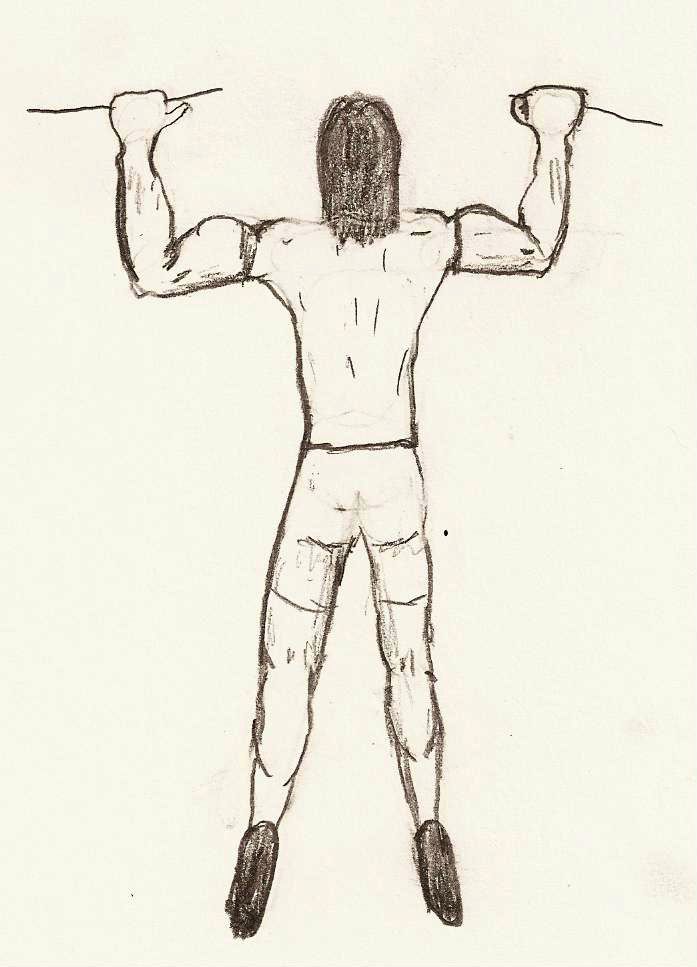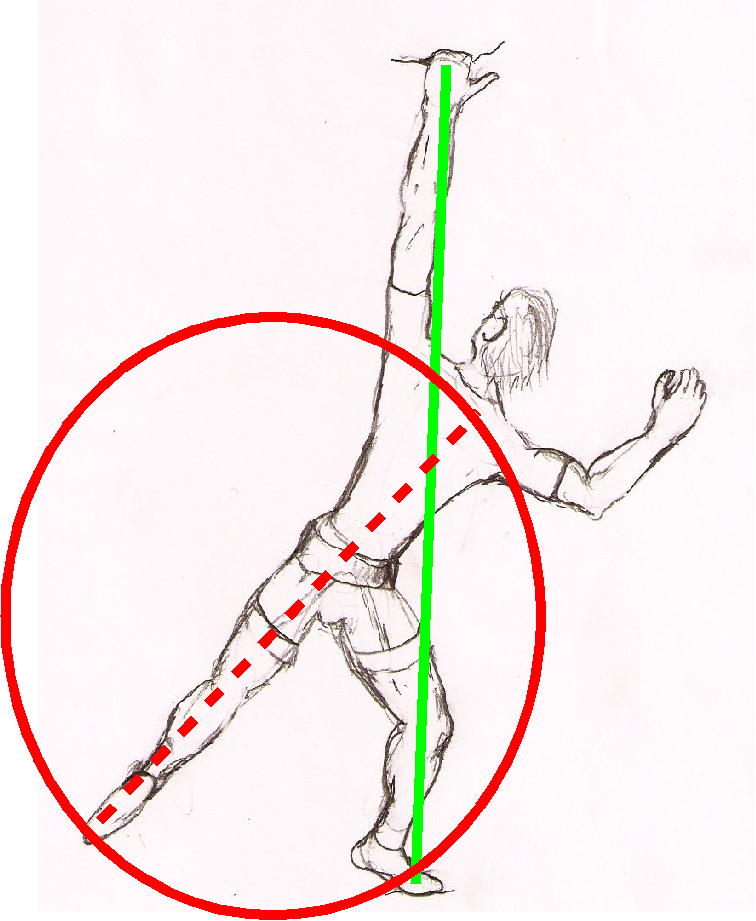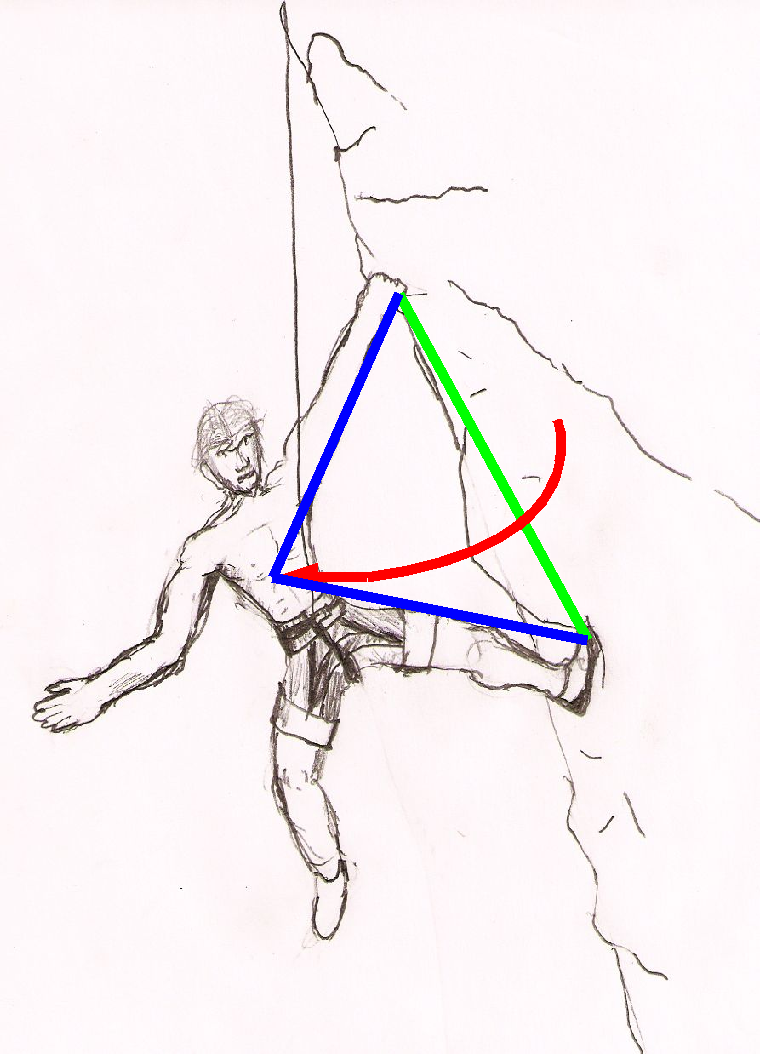The first rule of climbing is to climb on straight arms.
Compare these two pictures.


The climber in the first picture is supporting his weight on his skeleton. In both pictures, the climbers are actively using the muscles that keep the fingers curled, but the first climber is using only those muscles, the second climber is using far more. Aside from the obvious bicep and latissimus dorsai muscles, the bent arm position in the second picture shows a climber stressing out the muscles in the forearm. It is this mistake, spending too much time on bent arms, that is responsible for the pumped feeling a new climber gets after a few climbs. There is a tendon system that runs down your arm and connects to your back. when you climb on straight arms, you hang on this tendon system. It is a holdover from our monkey ancestors that swung through the trees. Remember crossing the monkey bars as a kid? You swung from straight arm to straight arm. When you climb up, you want to use straight arms, too.
Try this simple experiment:
Hold a book by the two fingers, one at the top of the binding, one at the bottom. If you hold the spine perfectly vertical, the pages splay out. If you tilt the book so the the top is no longer over the bottom, the whole book will rotate so the open pages are all pointed straight at the ground.
In geometry, we learn that a triangle is defined by three points, and that a plane is also defined by three points. We can make a triangle out of our book example with one point on the top of the spine, one on the bottom of the spine, and one in the center of gravity. What we see is that the plane defined by these three points will always rotate itself to align perpendicular to the ground. The two fixed points act like the hinges on a poorly hung door. The door will always swing to point toward the center of the earth.
This holds true for climbing. The simplest example is a climber holding on with both hands and no feet. The climber naturally dangles toward the ground. For people, the center of balance is typically the abdomen. Thus the triangle is formed by the two hands and the navel.
.
In order to move smoothly, you are going to be holding on to the wall with only two points of contacts much of the time. In order to it is far more important that you align the triangle of you body with the ground. If you don’t you will be fighting your bodies tendency to rotate. One way that climbers do this is to only move one limb at a time while keeping three in contact with the wall. This limits your options significantly. The other way is to try and overuse the muscles of the forearm to battle the rotation, causing premature flame-out.
The longest line of the body if from hand to opposite side foot. This follows either the red or green line of the body. Note that where these two lines cross is near the center of balance.

Let’s put together these items. The longest line of the body is from one foot to the opposite side hand, and this line crosses through the center of balance. We want to keep the center of balance in line with the contact points on the wall. This leads to body positions similar to the one displayed below.

First and foremost, the climber is holding on with a straight left arm. This climbers body is in line from left hand, through abdomen, to right foot. His left foot and right arm counter balance each other to keep his body in line. If he finds his center of balance is off, he can adjust either limb to bring it back aligned. If he moves is right hand in or out along the dotted red line, his center of balance will adjust in or out parallel to that line. Additionally, he can move his hand in a circle and adjust his center of balance accordingly as well.

His left leg follows the same rules. If he extends it out along the red dotted line,it pulls his center of gravity out along it. If he lowers his leg along the circle, he pulls his center of gravity in toward his body.

The general pattern in climbing, especially in the gym, it reach up with the inside arm, and then to pivot so that arm becomes the outside arm. When you reach up with your left hand, you left hip will be pressed against the wall. Once you have that hold, you will pivot so that your right hand is against the wall. The climber in the picture above could well end up in a position similar to this:

The climber is leaning back against the side pull held by the left hand. He flags his left foot to provide a counter balance. This moves his center of gravity toward the line between his right foot and his left hand. If he continues to torque around on this axis, he can push with his toe against the wall to provide a counter force. Once he grabs the hold with his right, he is likely to step through so his left hip is against the wall, standing on the outside of the left foot. This pattern of alternating the hip against the wall while reaching with the inside arm is a motion similar to swimming or salsa dancing.
Contrast this with an attempt to use both limbs on the same side of the body. When the climber lets go with the right hand, and unloads the right foot, gravity pivots his body around the axis of the two remaining points of contact and the climber ends swinging out from the wall, a movement called “Barn Dooring”

Here the green line shows the axis of the pivot, and the red arrow the movement of the swing.










